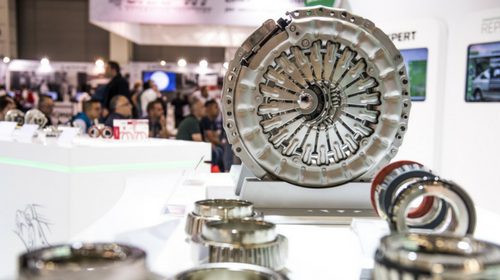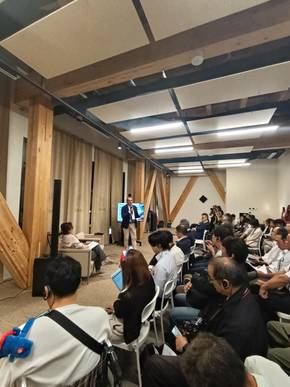
27/07/2017
Recycling while waiting tomorrow’s industry
Massimo Condolo
Multi-brand offers continue to simplify and speed up repair, while the proper awareness towards the value of a circular economy brings the virtuous process behind reconditioned spare parts to the fore
Will the 2019 edition showcase 3D printers? Probably, as these must be considered the forefront of a technology destined to become highly popular and widespread. The replacement market will certainly evolve in this direction, probably starting from slow moving niche models or items out of production. Meanwhile, the market will continue to maintain the current trend, with many stakeholders with different interests willing to establish to either long-standing or short term alliances: official networks, multi-brand networks, component manufacturers ... Multi-brand networks, on the other hand, are not ready to throw in the towel, as demonstrated by the arrival in Italy of two new brands, one dedicated to cars and one to trucks, each with its own spare parts catalogue. The latter can even boast two product lines, one that focuses on quality/price ratio and one that looks at establishing itself as a premium product line, with the ambition of becoming a “one-stop-shop” for transport fleets. In addition, gas system manufacturers have also confirmed their commitment to the sector supplying their distribution networks with the most commonly used spare parts for routine maintenance operations such as filters and lubricants, besides spare parts dedicated to LPG and CNG systems. Conferences on the topic of circular economy have highlighted the importance of reconditioned spare parts: on the one hand they save energy (with an average of 56% while emission reduction stands at 53%), on the other they allow to recycle raw material that would otherwise be scraped or used as secondary raw materials; furthermore, scrappers can reuse, even if not directly, a few safety components. Reconditioning is already a standard procedure on industrial vehicles especially as far as gearboxes, engines and turbochargers are concerned, and this should prompt to considered the validity of the process: on transport vehicles, safety and down-time are considerably more important than on a private car.
Component makers, quick and creative
Automotive components manufacturers have shown to be the most dynamic actors in the sector, both for the attention paid in setting up a capillary distribution network, thus reducing delivery times, and offerig reconditioning kit. These, at a competitive price, can help to eliminate assembly errors and replace all wearable parts without the risk of reassembling used components that are considered to be good in appearance but could compromise the life of new ones. Widely used on transmissions, these kits can also improve the quality of the original parts, as shown by a recent line of sealed bearings for wheel hubs able to double the useful life of the original component. The offer has been so far dedicated to heavy duty vehicles, a market segment that has always been very sensitive to the quality and performance of wearable parts, but will soon cover the medium and light transport sector as well as automobiles in the not too distant future. In fact, this is already the case with clutches, and the trend could affect all those areas of the vehicle whose components have a similar useful life, and where electronics is either not too invasive (such as on chassis) or not repairable (as in engine management systems). This is the case with brakes or injection system, where these kits can minimize assembly errors even when entrusted to hands that are not so expert.
Tuning is a serious matter
Strict controls and tougher approval regulations have considerably reduced the participation of manufacturers of tuning accessories – could it be that the message from German authorities a few years ago, "tuneitsafe" has perhaps also affected us? Probably; so much so, in fact, that accessories used in super-customized cars come from first-generation components, with obvious limitations in terms of safety, approvals and test cycles. There are some less sophisticated yet well tested accessories with good production levels, though. Recent developments revitalized also the replacement market for lighting system, which has taken a back seat in recent years, with LED technology under the spot light. Among OEMs some offer approved parts as retrofits for vehicles already in circulation. Meanwhile, China made a great impression during the show. Its market, waiting for Chinese vehicles to spread at our latitudes as well (it's only a matter of time: three or four major brands already feature in light commercial vehicles and buses in our country), is for the moment restricted to cheap Asian models and older Western models – for which the manufacturers are no longer interested in maintaining a dedicated production line for spare parts. On the other hand, a few European spare parts producers are still active in the truck segment, and still produce spare parts for past vehicles to be found especially in Africa and South America. But Asian competition keeps growing, putting their leadership in danger.
Lubricants too are evolving
Developments on lubricants follow the regulations on engine emissions: the last big wave came with the Euro 5 regulations with many lubricants already Euro 6-compatible. Even in this case the current evolution started with large transport engines (called on to comply for the first time with the new emission standards), and then went on to smaller and faster engines. One of the greatest innovations involved diesel engines for light passenger cars and commercial vehicles, with the approval of a major manufacturer. Despite greater power and displacement it still features a further drop in viscosity, but for now this cutting edge engine is still running on a test bench. Finally, a word on brake pads: Some time ago they were deprived of asbestos, now it is the turn of the heavy metals responsible for producing the red dust that is quite common in many cities. An effective demonstration of eco-friendly brake pads on the part of a large OEM component maker was one of the major attractions with the public, which had the opportunity to see firsthand how they can have great high-performance brakes without polluting. And even in this case, as we have seen for bearings, improving the durability of the components is paramount: if brake pads have almost doubled their useful life, brake disks, on the other hand, have seen their useful life grow almost fourfold.
Component makers, quick and creative
Automotive components manufacturers have shown to be the most dynamic actors in the sector, both for the attention paid in setting up a capillary distribution network, thus reducing delivery times, and offerig reconditioning kit. These, at a competitive price, can help to eliminate assembly errors and replace all wearable parts without the risk of reassembling used components that are considered to be good in appearance but could compromise the life of new ones. Widely used on transmissions, these kits can also improve the quality of the original parts, as shown by a recent line of sealed bearings for wheel hubs able to double the useful life of the original component. The offer has been so far dedicated to heavy duty vehicles, a market segment that has always been very sensitive to the quality and performance of wearable parts, but will soon cover the medium and light transport sector as well as automobiles in the not too distant future. In fact, this is already the case with clutches, and the trend could affect all those areas of the vehicle whose components have a similar useful life, and where electronics is either not too invasive (such as on chassis) or not repairable (as in engine management systems). This is the case with brakes or injection system, where these kits can minimize assembly errors even when entrusted to hands that are not so expert.
Tuning is a serious matter
Strict controls and tougher approval regulations have considerably reduced the participation of manufacturers of tuning accessories – could it be that the message from German authorities a few years ago, "tuneitsafe" has perhaps also affected us? Probably; so much so, in fact, that accessories used in super-customized cars come from first-generation components, with obvious limitations in terms of safety, approvals and test cycles. There are some less sophisticated yet well tested accessories with good production levels, though. Recent developments revitalized also the replacement market for lighting system, which has taken a back seat in recent years, with LED technology under the spot light. Among OEMs some offer approved parts as retrofits for vehicles already in circulation. Meanwhile, China made a great impression during the show. Its market, waiting for Chinese vehicles to spread at our latitudes as well (it's only a matter of time: three or four major brands already feature in light commercial vehicles and buses in our country), is for the moment restricted to cheap Asian models and older Western models – for which the manufacturers are no longer interested in maintaining a dedicated production line for spare parts. On the other hand, a few European spare parts producers are still active in the truck segment, and still produce spare parts for past vehicles to be found especially in Africa and South America. But Asian competition keeps growing, putting their leadership in danger.
Lubricants too are evolving
Developments on lubricants follow the regulations on engine emissions: the last big wave came with the Euro 5 regulations with many lubricants already Euro 6-compatible. Even in this case the current evolution started with large transport engines (called on to comply for the first time with the new emission standards), and then went on to smaller and faster engines. One of the greatest innovations involved diesel engines for light passenger cars and commercial vehicles, with the approval of a major manufacturer. Despite greater power and displacement it still features a further drop in viscosity, but for now this cutting edge engine is still running on a test bench. Finally, a word on brake pads: Some time ago they were deprived of asbestos, now it is the turn of the heavy metals responsible for producing the red dust that is quite common in many cities. An effective demonstration of eco-friendly brake pads on the part of a large OEM component maker was one of the major attractions with the public, which had the opportunity to see firsthand how they can have great high-performance brakes without polluting. And even in this case, as we have seen for bearings, improving the durability of the components is paramount: if brake pads have almost doubled their useful life, brake disks, on the other hand, have seen their useful life grow almost fourfold.








